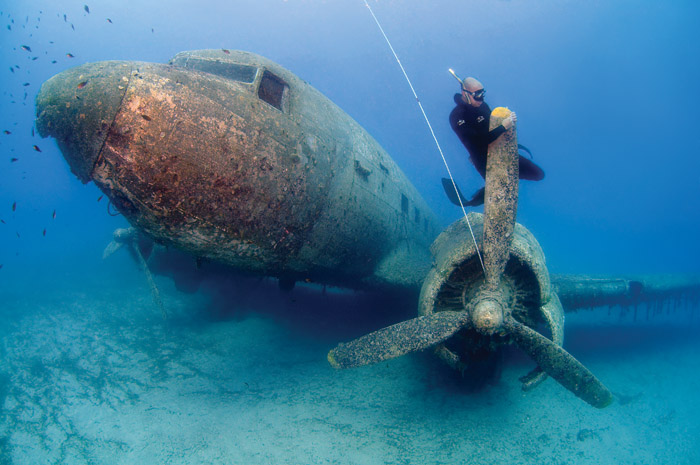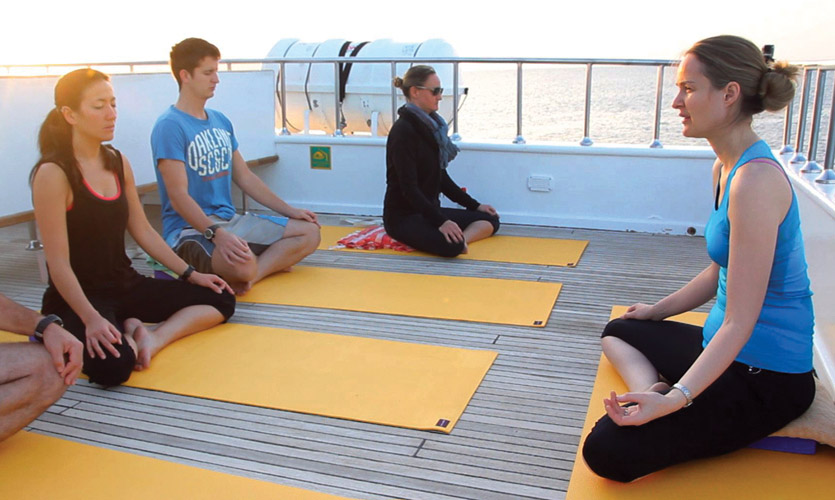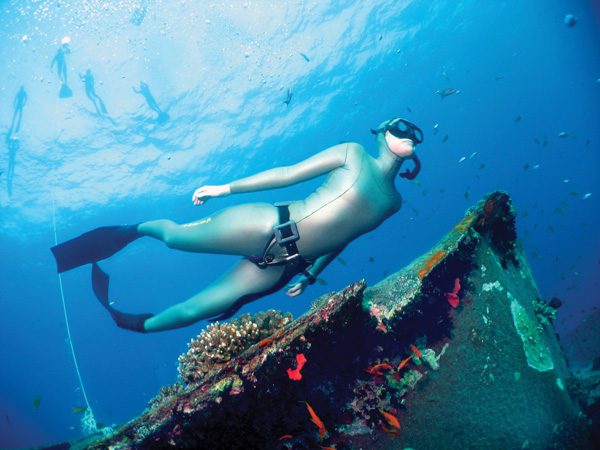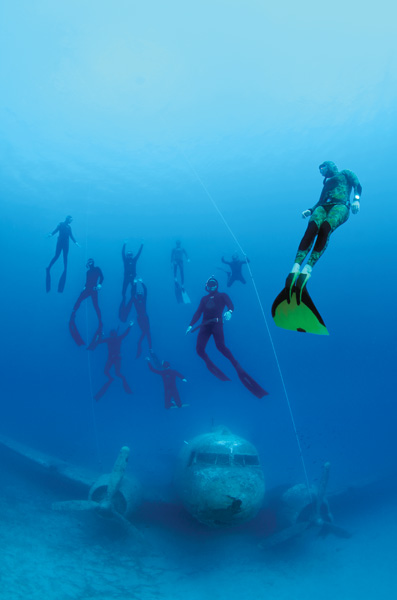Diving Free
It’s been said that if you want to know why dolphins are always smiling you should join them. Welcome to the world of breath-hold diving!
Text by Richard Fleury

One of the world’s top wrecks, the SS Thistlegorm attracts exotic marine life. And today a creature seldom seen on the famous Red Sea attraction weaves through her broken superstructure and ruptured cargo holds. Camera flashes ignite as this graceful marine mammal glides into frame. Its silver grey skin is dolphin-like and its fluid descent suggests an affinity for the aquatic realm. But this animal is human – a freediver.
Breath-hold diving, or apnea, is thousands of years old. In its modern ‘extreme sport’ incarnation, it tends to make headlines when a competitive freediver sets a superhuman new depth record or, tragically, dies in the attempt. But there’s another side to freediving. It is also a relaxing, peaceful and – with proper training – safe way to enjoy the underwater world unencumbered by bulky equipment and airlines’ excessive excess baggage charges.
It’s also surprisingly accessible. Diving to scuba depths with only the air in your lungs sounds daunting but the human body comes equipped with a complex repertoire of physiological responses to submersion. These include the shift of blood to the lungs and heart and an automatic slowing of the heart rate called bradycardia. This Mammalian Dive Reflex is something we share with seals, otters and sea lions. Some scientists suggest it may even point to an aquatic phase in human evolution, the so-called Aquatic Ape Theory.
Watch a top freediver like the legendary Umberto Pelizzari dive and the theory seems totally plausible. A seal’s heartbeat plummets to six beats per minute the moment its head dips under the surface. During a deep dive, Pelizzari’s pulse reportedly drops to just eight beats per minute.
Freediving’s top athletes can dive to 650 plus feet (200m) – deeper than a WWII submarine – and achieve breath holds longer than 10 minutes, far beyond average capabilities. But with training, we can all dive deeper and for longer than we imagine. For a reasonably proficient freediver, reefs and wrecks lying in 100 feet (30m) or less are safely accessible on a single breath.
Aboard the MV Mistral, I’m among 21 divers on a holiday expressly for free divers. We’re a mix, from complete newbies to veterans, all keen to learn more of the breath-hold experience. A new venture offered by dive operator Scuba Travel and world-class apnea instructor Emma Farrell, the week-long live-aboard trip will open up dive sites previously beyond the reach of breath-hold divers.

Most Practice Yoga
The sport has come a long way since French freediving pioneer Jacques Mayol became the first human to reach a depth of 330 feet (100m) back in 1976. He was inspiration for Luc Besson’s 1988 cult movie The Big Blue, along with Italian diver Enzo Maiorca, a friend and competitive rival. Because of his special relationship with dolphins, Mayol was called ‘Dolphin Man’ and was also one of the first freedivers to use yoga in training. Today, the majority of serious freedivers practice it in some form. Former commercial diver Derek White and his wife Sue use yoga to stay in shape for freediving. Both 55, the UK couple are among the more mature divers on board. “It helps with relaxation and flexibility, which helps you move through the water,” explains Sue, who took up freediving five years ago.
Derek – tanned, barefoot and wearing a silver dolphin fluke pendant, vest and baggy ‘MC Hammer’ yoga pants – couldn’t look any more relaxed if he was in a medically-induced coma. A freediver since the 1970s, when he briefly trained with Jacques Mayol, he believes SCUBA divers can benefit enormously from learning to freedive. “Freedivers have to be efficient in the water or you waste energy and oxygen and that’s something that can be passed on really well to scuba divers.”

Cool and Challenging
Emma Farrell has taught freediving skills to more than 1,000 people including surfers, spearfishers and swimmers. A qualified yoga teacher, she is so alarmingly bendy she can cross her legs behind her head without a hint of a grimace. Twice a day, she leads optional yoga sessions on deck.
“Anybody can learn to freedive,” she says. You’ve got a whole range of ages and abilities. But everyone’s encouraged, no matter what standard they are and how they do.”
Many of her students are SCUBA divers. Some sign up for her ‘Gas Guzzler’ courses to reduce their air consumption, others are tech divers who find it helps them stay calm and focused at depth.
Sometimes it seems a ‘them-and-us’ divide exists between freedivers and ‘scoobies’. But many freedivers, like Derek and Sue, are also seasoned SCUBA divers. It’s just a different way of enjoying the underwater world. Increasingly though, newcomers to the sport have no previous diving experience at all.
“People entering the sport are interested in something new, cool and different,” says Emma. “In the past it was more men than women. But the tide is changing considerably and now it’s half and half. Freediving is emotionally and psychologically challenging and people like that.”

Just after dawn each morning, a handful of puffy-eyed divers shuffle up to the sun deck, wash down a cleansing cup of lemon water and, led by Emma, perform the ancient Hindu ‘Sun Salutation’. I’m not knocking this but a glass of battery acid, impersonating a contortionist and scorching your retinas before the rising sun… I don’t know. There is probably no healthier preparation for a day’s diving but for me, one session is enough. I decide instead to stick with my own tried-and-tested wake up ritual: a sit down with a cup of strong coffee.
At night, after dinner and the sun have both gone down, the day’s gigabytes of fish pictures have been downloaded and videos screened on the Mistral’s plasma, it’s time for more yoga. This time it’s Yoga Nidra, a relaxation technique so potent it borders on voodoo. This is much more my pace. Flat on our backs under an ocean of stars, we let Emma guide our minds on a hypnotic trip, her mesmeric tones inviting us to imagine the crowns of our heads as lotus flowers, “shedding thousands of golden petals”. I’m not sure what a lotus flower looks like, so I visualize a sort of psychedelic dandelion instead which seems to do the trick.
Mind Game
Relaxation is key to freediving. Anything that raises your anxiety level, heart rate and therefore oxygen consumption is bad news. It’s a mind game, the only adrenalin-free extreme sport. By mastering your emotions, you can control your body. Eventually, so I’m told, the urge to breathe no longer registers as discomfort but just another state of being.

It is physically challenging but mental strength will take you deeper than physical fitness alone. The physically toughest diver on the trip, a soldier, struggled the most psychologically as depths increased.
It’s sometimes said that SCUBA diving is about what’s happening around you, while freediving is about what’s going on inside. Instead of monitoring the hardware attached to their bodies, freedivers listen to their bodies. They are conscious of their own heartbeat, the six or more litres of air in their lungs – ‘nature’s doubles’, body position, muscle tension and state of mind. Preparing for a dive, or ‘breathing up’ in choppy water, I find it hard to loosen up at first. But after a couple of Yoga Nidra sessions, it’s easier to float calmly and literally let it all wash over.
The first of its kind, the trip is a learning curve for the Mistral’s crew and diving instructors. Sea conditions are all-important. Currents and waves shrugged off by ‘scoobies’ can be risky for freedivers. “It’s not just snorkeling and it’s not just SCUBA diving without the tanks,” says Emma. “It has completely different requirements.”
At least one dive session each day is a ‘line training’ session. The crew find sufficient depth, then suspend weighted ropes between buoys. Clipped to these lines by quick-release wrist lanyards for safety, we practice diving deeper and more efficiently. Sometimes, we descend through shoals of electric blue fusiillier fish congregating around the line. Another morning, a nosey lone dolphin swims by to investigate.
People from all walks of life discover their subaquatic selves through freediving. Among the divers on board the Mistral are a lawyer, carpenter, a doctor and a soldier. Most are training for a Scuba Schools International (SSI) Level One, Two or Three freediving qualification.

Happy to Push
“Everyone here is happy to push themselves outside their comfort zone,” says 28-year-old naval engineering officer Mike Emptage who graduated from snorkeling to freediving just last year and now has a 140-foot (42m) dive under his weight belt.
“The progression can be quite quick from shallower to midrange depths,” says 35-year-old environmental consultant Heather Coutts, a SCUBA diver since her teens and a diving instructor for 12 years. “I didn’t start freediving with any expectations,” continues Heather, who began training last summer and hit 102 feet (31m) on the last day of the trip. “But depth is addictive and once you’ve got a personal best, you just want to go deeper.”
I’m a SCUBA diver and learned to freedive five years ago, just long enough to forget everything. But with a week’s training and practice, it all comes back and I manage a personal best depth of 66 feet (20m).
“There’s a lot to think about,” says my instructor Dennis Walker, as we prepare to dive in the sheltered water of Marsa Bareika bay on the last day of the trip. “Keep your head down, chin tucked in and fin with legs straight. Try to plan your dive.”

I ‘breathe up’ through my snorkel, face down and focus on relaxing my limbs, floating effortlessly in the water, listening for a slowing heartbeat. My final breath pulls air into the abdomen, chest then upper chest until my lungs feel like overinflated beach balls.
Spitting out my snorkel, I duck dive, pull down with my arms and start finning. The rapid descent through the first few metres requires constant equalization to avoid unhelpful knitting-needle-in-the-eardrum sensations.
Halfway down. No longer buoyant I start to sink without effort. Carbon dioxide builds up, a nagging invitation to panic. Ignore it. You can hold your breath for at least a couple of minutes. Plenty of time left.
Falling now. It feels oddly peaceful. Glance down. Almost there. I reach the bottom of the line, my hand touching sandy seafloor. Pause for a moment like Dennis told me. Relax, tell yourself you’re okay. Look up the line to the waves above. My word, that’s a long way. Time to go. Strong, slow kicks upward. Resist the urge to sprint. Stop finning at 33 feet (10m) to save oxygen and let buoyancy lift you gently to the surface, just like Dennis said. Oh, here’s Dennis now. He’s dived down to join me, watching my eyes for signs of impending blackout. Lungs burning but I resist the urge to kick. Save those remaining 02 molecules. Break the surface. Big, fast ‘recovery breaths’. Bigger smile.
Line work is vital for building skills and confidence safely but recreational dives put the free in freediving. As well as the Thistlegorm, the Mistral’s itinerary includes freediving on Gordon Reef, Jackson Reef and the SS Dunraven wreck.
With gear pared down to mask, snorkel, weight belt and long fins or monofins for extra power, freedivers are fast and agile. Bottom time is limited, of course, and a leisurely tour of a wreck or reef is out of the question, but you can make repeated dives just a few minutes apart. And the absence of noise and bubbles gets you closer to marine life.
One evening, after a wreck dive, a frisky pair of bottlenose dolphins appears alongside the Mistral, playing in the boat’s lights. There’s a scramble for fins and masks as divers – some still in their undergarments – plunge into the water and thrash after the visitors. Amused by the attention, our new friends stay for more than an hour. It seems like minutes. They swim and dive with us, mimicking our movements, plunging and corkscrewing through the dark water. Long after they have exhausted us, these wild animals want to carry on playing. The surprisingly emotional encounter leaves everyone buzzing with a profound joy. I’m not about to hang up my regulator forever but, that night, we all understood what makes freediving special. I think Jacques Mayol would have approved.
Leave a Comment







